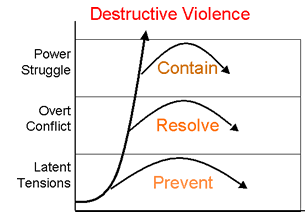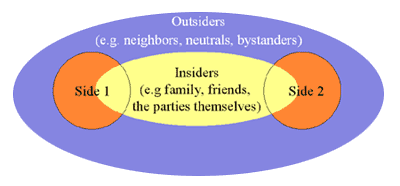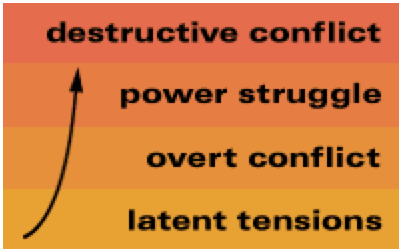Isn’t “War” Human Nature?
Coexistence for 99% of our past?
Underlying our hopelessness is the story we commonly tell ourselves and our children about our past. People have been warring with each other since the beginning of time. Scratch the veneer of civilization and you will get a Kosovo or Rwanda.
For the last ten thousand years – during the last one percent of human evolution – there exists clear and often abundant evidence of organized violence and warfare. It takes the form of bones with spearheads or arrowheads embedded in them, mass graves, remains of fortifications, settlements destroyed violently, and ancient art depicting scenes of war and carnage. Much of the evidence of violence antedates “civilization” – defined as the building of cities, the invention of writing, and the birth of the state. There can be little doubt that violence and war leave clear traces in the archaeological record.
What is surprising, therefore is that convincing evidence of organized violence becomes so sparse before ten thousand years ago. In the period from ten to fourteen thousand years ago, there are two credible if controversial sets of evidence of small group violence, a cemetery in Jebel Sahaba, Sudan, and rock paintings in Arnhem Land, Australia; both instances seem to have occurred in the wake of catastrophic ecological change. Beyond that, there is evidence, in at least nine skeletons, pointing to scattered individual killings stretching back across time, but little or no evidence of war itself.
This doesn’t mean that our ancestors never killed one another. They almost certainly did. But they appear to have coexisted much more than they fought. And we’re not talking about an insignificant period of time, but 99% of our time on earth.
False polarities
The debate has long raged in and out of anthropology: Humans are naturally aggressive; no, aggression is learned. War is genetically based; no it is not. The answer is not one or the other but both. The polarities turn out to be false polarities. In these questions, there are no absolutes; everything is a matter of degree. In seeing only absolutes, one misses the critical degrees, yet it is in these degrees that lie the answers to the questions of how humanity has gotten along in the past and how we can get along in the future.
The debate, often fierce and emotional, unfortunately obscures where, in fact, scientists and scholars do agree. Few would disagree that humans are both capable of violence and capable of controlling violence. Most would acknowledge that humans sometimes live in a sustained condition of war but also sometimes live in a sustained condition of relative peace.
If human beings were as inevitably aggressive as we are often pictured, why do we not kill each other far more than we actually do? All the police in the world could not keep people from doing what comes naturally. If war is our natural state, why do the great majority of human conflicts not end in violence? How is it that human societies can live in internal peace and coexist nonviolently with their neighbors for long periods of time?
Just because we naturally eat doesn’t mean we need to overeat. Just because we like sex doesn’t mean we need to rape. Just because some humans like to dominate doesn’t mean we need to enslave others. That aggression is innate doesn’t mean that violence and war are inevitable. Indeed, there is nothing wrong with aggression in itself; primate mothers, for instance, use mild forms of aggression to teach their offspring correct behavior. It all depends on how the aggression is expressed and for what purpose.
Capable of war, capable of peace
Human behavior is extraordinarily flexible, as is reflected in the extreme variation in societal rates of violence. Some indigenous cultures like the Waorani of Ecuador manifest levels of violence as much as a thousand times higher than others, such as the Semai of Malaysia. Or consider the contrast between England and Colombia, more than fifty times more violent. Some of us live in societies that more closely resemble England in levels of violence, others in societies that more closely resemble Colombia, and most of us live somewhere in between. The level of variation alone suggests that far more than human nature is at play. One does not find whole societies that eat or make love even ten times more often than others, let alone a thousand times.
The variation derives, in great measure, from how people choose to deal with their differences. Violence is not an autonomous phenomenon but one choice among many for handling disputes. People are constantly coping with conflicts, their own and those of others, making choices as to which procedures to use. Humans, in other words, are conflict managers.
Our common assumptions about human nature are mistaken. We are not by nature killer apes – one end of the continuum. This does not mean that we are naturally peaceful or harmonious either – the other end of the continuum. Rather, we are capable of both destructive and constructive responses to our differences. The answer to the assertion that “War is human nature!” is, “Yes and so is peace.”
Our potential for change
Given our daily news diet of wars, street violence, strikes, lawsuits, and political battles, the conventional picture of human beings as naturally prone to violence is understandable. It misses, however, one fundamental point: Most of the time, most people get along. Although we may not give it much thought, we know this from personal experience. Despite differing temperaments, habits, and communication styles, most husbands, wives, and children manage to live together. Although they may disagree on basic values, most neighbors succeed in living side by side. Despite opposed interests, labor and management work together most of the time. Even with all their disputes, most nations are at peace with one another. The great majority of relationships among individuals, groups, and nation states are characterized far more by coexistence than by ongoing destructive conflict. Even in this most deadly of centuries, most people around the planet have lived most of their lives in a condition of peace, not war. Peace is the norm.
It is time, then, to stop thinking of peaceful coexistence as merely a vision. It is a reality. This is not to belittle the existence or importance of strife and war; far from it. It is just to remind us of the prosaic preponderance of peace.
Seeing human life as peaceful conflict resolution interrupted by periods of strife, rather than the other way, around transforms the challenge from the negative one of ending war to the positive one of extending the peace. Our task is not to change one absolute – war – into another absolute – peace. It is not to go from zero percent peaceful interaction to a hundred percent, but rather to go from something like ninety percent to something like ninety-nine percent.




